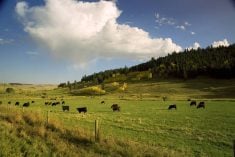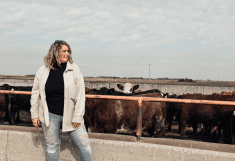Social media, news articles and conversations around the dinner table don’t always have a positive story to tell about Canadian beef, but that may be rooted in uncertainty more than negativity.
While people from every generation are questioning beef’s roles in diets, markets and the environment, recent public perception research done by the Canadian Cattle Association shows plenty of positive perceptions of the beef industry and its products.
Canadian beef got top marks for its taste, quality and role in a healthy diet from the 2,300 participants surveyed in July 2023. A quarter of gen Z participants (those born between 1997-2013) even said they want to incorporate more meat overall into their diets.
Read Also

The Canadian Cattle Association’s international advocacy efforts
Global ag policies affect Canadian food policy, so the Canadian Cattle Association participates in international and domestic forums
And yet when a quarter of participants said they want to eat less beef, cost and environmental concerns were deciding factors. Survey participants saw beef as taking the greatest toll on the environment. Beef was tied with seafood and fish as being perceived as the most expensive.
The survey will influence how the association reaches out to the public, especially “curious consumers,” defined as people who love the product but are unsure about farm practices, says Amie Peck, stakeholder engagement manager with the association. People want more information — 94 per cent of respondents, especially urban and young Canadians, are saying they want to know more about how beef is raised.
A little over half the respondents said they believe the industry treats animals humanely and that ranchers are trying to limit their environmental footprint. Peck says they saw several “I don’t know” responses in the survey, especially when it came to perceptions of farming practices and animal treatment on the farm. She sees these numbers as indicating uncertainty and a lack of knowledge.
“Just because we’re not seeing high numbers indicating positive feelings, it doesn’t mean that there’s also negative. We saw very, very few negative perceptions about any of the practices on farms and that’s really, again, because people just don’t know enough to make a decision either way.”
People don’t always know how to get informed, says Peck. For the industry, getting that information out is becoming increasingly important and challenging.
The survey itself was as statistically representative of the Canadian population as possible, says Peck. Every province and demographic were proportionally represented, as were age demographics. From there, Peck says they can look at individual questions and see where attitudes and concerns are the most prevalent by province, and even urban attitudes and beliefs versus rural. Looking at different age demographics, Peck says they can also look at the best ways to produce and package information for different audiences. For instance, gen Z is most often using YouTube to find information, especially about comedy, food and entertainment. That information is going to influence their campaigns, says Peck.
“For us, how can we get more content on YouTube, that’s either in one of those same categories or bordering it, so that we can get more of these things directly in front of them in ways that they’re already consuming content?”
Social media, whether good, bad, or otherwise, plays a huge role in how people receive and process information about the agriculture industry. However, it has been obvious through this and other surveys within the industry that people trust stories coming directly from the farmers and ranchers themselves, says Peck.
“We’re always utilizing farmers and ranchers as our spokespeople, but I would really encourage producers across the country to feel that they are the right ones to do public outreach. People do want to hear from them.”
Connecting them with influencers and content creators has been the best way of linking these agriculture and social media worlds, but Peck knows not everyone is comfortable in that space. If they haven’t already or are looking for different opportunities, she encourages all farmers and ranchers to keep getting involved within the industry, whether that’s with educational agriculture programs, volunteering on local, provincial and national boards, or participating at fairs and exhibitions.
This is the second survey the public and stakeholder engagement team has done on attitudes towards beef and the beef industry, the first being done in 2020.
Now that they have multiple years of information, Peck says they can start tracking how attitudes change over the years and set goals to improve these perceptions in key areas, such as environmental footprint and the healthiness of beef.
“For the first time, we’re actually able to compare perceptions and see where they’ve remained steady and where they’ve maybe gone up or gone down.”
The Canadian Cattle Association’s public and stakeholder engagement program focuses on building public trust and addressing national issues throughout the beef industry.
– Becky Zimmer is a freelance journalist based in Humboldt, Sask. Her farming and small-town background has given her a wealth of knowledge and passion for Prairie journalism, provincial and national government policies, civic politics, community events and the challenges of rural health care and infrastructure.















